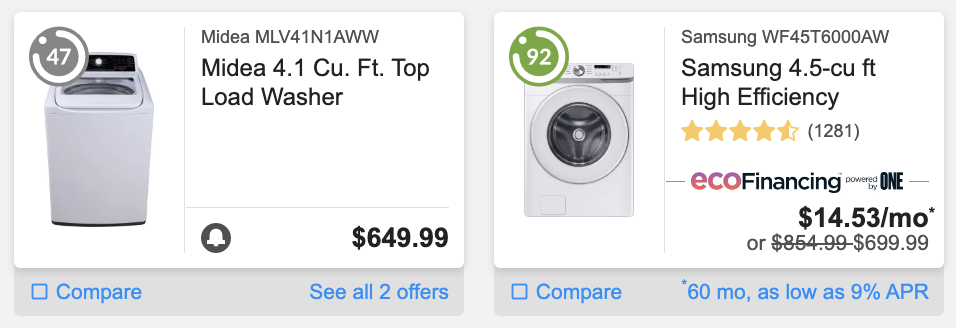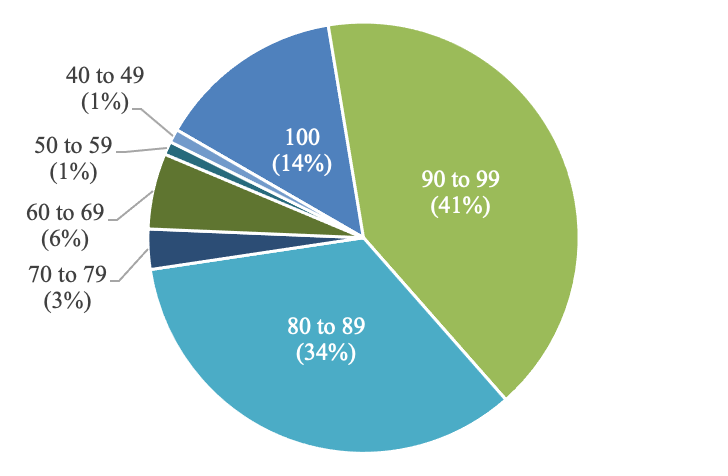Product efficiency has increased and unit energy consumption has declined over time, due to product innovation, mandatory energy efficiency standards, the ENERGY STAR label, and consumer preferences. Below we share insights from Enervee data on the added value of the Enervee Score and industry partnerships to speed innovation cycles.
By updating standards for 47 products, it has been estimated that the Department of Energy could reduce peak electricity demand by an additional 90 GW by 2050, which is equivalent to about 13% of current total peak demand [1]. But that still leaves products with a wide range of efficiency levels on the market. How do we increase demand for and purchases of ever more energy efficient products?
The Enervee Score is a zero to 100 relative energy efficiency rating, which serves as a visual cue to help shoppers choose more efficient products [2]. The clothes dryers with Enervee Scores above 90, for example, rely on heat pump technology. By re-using most of the heat, a heat pump dryer is more efficient and avoids the need for ducts to the outside of the home. While heat pump dryers can cost as much as $1,900, they currently start around $800, which is competitive with similarly-sized conventional electric models that are less energy efficient.

The conventional dryer on the left consumes 260 kWh/year and costs the same as the heat pump model on the right that uses 44% less electricity (145 kWh/year). Over the 16-year lifetime of the dryer, the super-efficient model would save 1,840 kWh and cut electric bills by $250, assuming a national average of 14 cents/kWh, or as much as $680, if you happen to live in high-priced Hawaii.
Enervee Score in practice
As illustrated above, the added consumer value of the Enervee Score is evident. It points shoppers to the most energy efficient models to meet their needs. But the Enervee Score does more than make product efficiency visible; it also drives super-efficient retail purchases.
There are several mechanisms at play here:
- Engaging the market in promoting efficient products. The Enervee Score provides retailers and manufacturers with the opportunity to promote efficient products by offering special discounts. In the following example, nationwide retailer Best Buy is discounting the price of the 92-scoring high-efficiency Samsung washer by $155, ensuring price parity with many less-efficient, top-loading models.

- Making financing available on efficient purchases. Coming up with the money to pay for a major appliance purchase can generally be a barrier, and financing allows people to break down the purchase price into affordable monthly payments [3]. The cheapest new washers, which are all inefficient top-loading models, cost around $500, but the monthly payment for the Samsung washer example is under $15 a month.
What this means for the consumer is that they can buy a highly efficient front-loading washer that uses only 90 kWh per year for the same price as the top-loading washer that uses 22% more energy (as well as more water) – and they can pay for it with affordable monthly payments.
Highly efficient product purchases – for all
This combination resonates with shoppers and results in highly efficient purchases.
Dishwashers, clothes washers and gas dryers bought via Enervee’s online marketplace featuring integrated Eco Financing are highly energy efficient. Eighty-nine percent had Enervee Scores of at least 80, with an average of 88 and a median of 90, despite the fact that products with scores as low as the 60s were eligible for Eco Financing. In addition, 14% of products scored 100, meaning they were among the most efficient available the day they were purchased.

In addition, for both washers and dryers, the average scores are higher for financed purchases than for purchases paid for with a credit card, as is the share of 80+ scoring products.
Given that the vast majority of loans have gone to underserved borrowers (living in census tracts defined as low- and moderate-income, or without access to credit), our program is proving successful at driving highly efficient purchases by people with lower incomes, lack of access to credit and renters.
Spurring continual innovation
This brings me to the concept of technology forcing standards (TFS). Not to be confused with Federal and state minimum energy performance standards, which cause manufacturers to eliminate production of the least efficient models previously sold.
Technology forcing standards complement minimum standards by establishing a high- performance benchmark that accelerates the market introduction & diffusion of cutting edge products. While work under the auspices of the International Energy Agency defined TFS as a future standard set by a government entity that cannot currently be met by commercially available products [4], we look at it more conceptually.
The technology forcing approach fosters continual improvement, rather than locking in any particular technology or level of ambition, and it stimulates innovation, while preserving industry flexibility and creativity. Engaging industry actors beyond original equipment manufacturers is another advantage. The daily-updated Enervee Score serves as a dynamic benchmark to spur continual improvement in product efficiency by manufacturers, both directly and indirectly – by allowing Enervee to engage other market actors (e.g., Best Buy’s voluntary product discount mentioned above) and drive consumer demand for ever more efficient products.
The ENERGY STAR label has also played an important role, but it is not a consistent guide to the most efficient products. In 2020, the most recent year for which ENERGY STAR shipment data are available, 100% of dishwashers, 55% of clothes washers and 37% of electric dryers carried the ENERGY STAR qualification [5]. In contrast, the dynamic nature of the Enervee Score means that the technology forcing function is maintained, even as the market evolves. The range in Enervee Scores for ENERGY STAR dishwashers, for example, is 62 to 97, for washers is 66 to 100 and for electric dryers is 53 to 100, offering a much more transparent view of the overall market for consumers, manufacturers and retailers alike.
Minimum standards have been the workhorse of energy efficiency in the past, but the urgency of aggressively combating climate change dictates that we do everything we can to speed innovation and drive deployment of the most energy efficient products. The opportunity to rely on the Enervee Score to set dynamic high-efficiency performance benchmarks across dozens of categories nationwide opens up exciting new avenues to transform markets, by effectively empowering consumers and engaging retailers, manufacturers and other market actors.
Notes
[3] Predicting the human response to Eco Financing
[4] Technology-Forcing Standards for Energy Efficiency
[5] ENERGY STAR® Unit Shipment and Market Penetration Report: Calendar Year 2020 Summary

